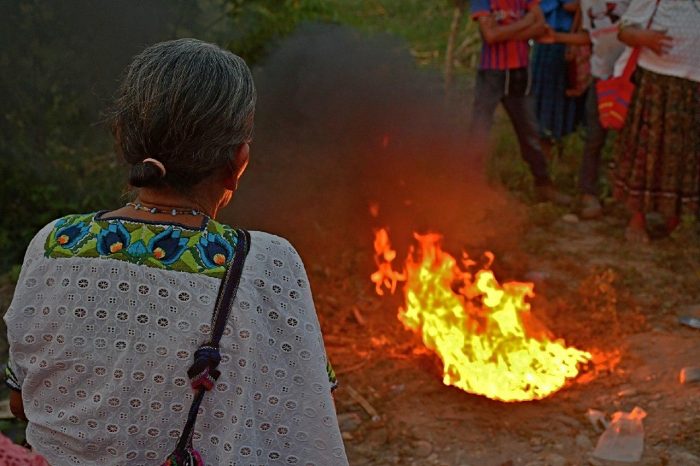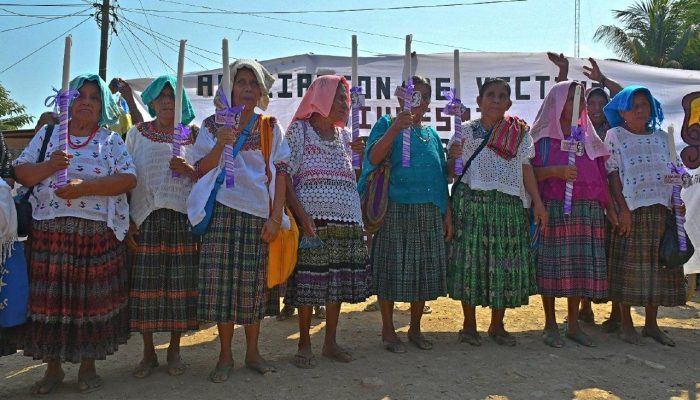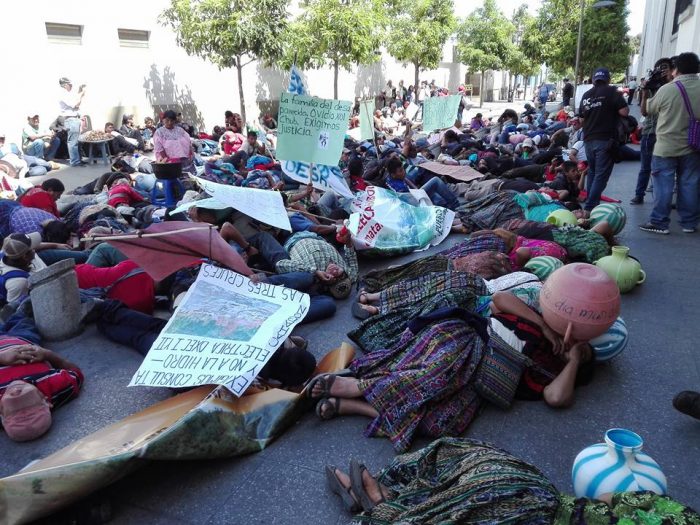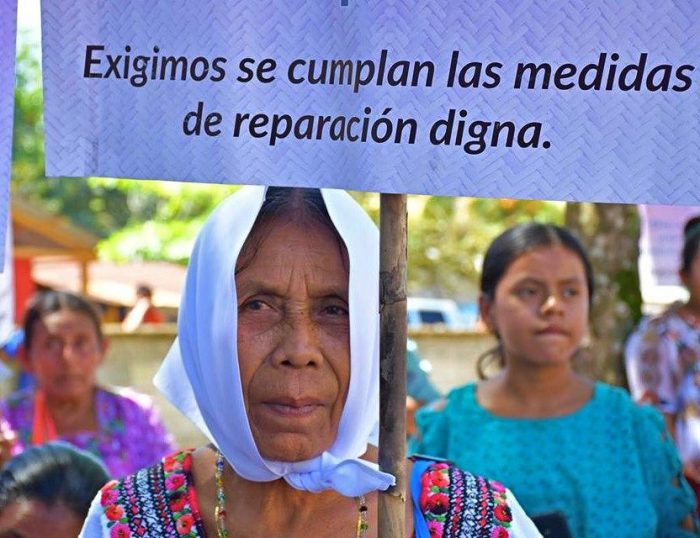Issue 18: Of Passageways and Portals
Ana Lucía Ixchiu Hernández, Maya Juracán
Reading time: 10 minutes

18.05.2020
Building off the experience of the body in times of confinement, artist and cultural producer Ana Lucia Ixchiu Hernández and curator Maya Juracán, from Guatemala, problematize the social role of art in a time when art has relegated to the sidelines its potential to connect us communally to our bio-surroundings, to others, and to the body itself in the name of capitalism.

Within the capitalist system, bodies are disposable. Some people are more important than others. We know this well. For more than 520 years, this has constituted the logic that excuses the damage that has been inflicted upon bodies that do not conform to the normative white social order, that has been used to justify ‘acceptable’ losses and the seizure of our communal autonomy through the destruction of our territories.
Those who uphold the capitalist scheme have continually attempted to undermine our ability to think outside the conditions that have been imposed upon us. For this reason, making our political movements visible is a vital strategy for continuing to imagine ourselves as communities in resistance. Art offers a potential pathway to these ends. At the forefront of the all-encompassing capitalist system, art, however, also acts as a mirage, making us believe that the exercise of sustained creation is something we can all participate in—for art speaks of a supposed space of freedom. In spite of this, at its core, the capitalist system which dominates by dictating to us a story of liberty rooted in production and accumulation—one that is only available for certain experiences and imaginations—is much more powerful. Art too becomes engulfed by this system: it materializes as a product to be monetized, accessible only to those who are able to acquire it, understand it, move through it. The hierarchy of access—inevitably classist and racist—results in the reduction of art produced by communities in resistance to the level of artesanía [folk craft]. In the same way, when people speak of “indigenous art,” they are romanticizing this production from the point of view of the white gaze, which mobilizes the ideal of the “wise Indian”—with all his virtues and visions, cures included—in order to divert the conversation through colonial fantasy and in this way avoid talking about the resistance of those bodies, those bones, that have refused to decay in the “civilizing” models.
By making us forget about the body that embodies resistance, that carries the weight of day-to-day life, artist Reyes Josué introduces the temazcal into the dialogue around art. A symbolic space of warmth and healing, the temazcal is profound, poetic, and spiritual. It is dedicated to the relaxation and care of the body. In the temazcal, the body is recognized as elemental matter in a flow of life that does not conform to the boundaries drawn by Western anatomy. It is an entity that has the capacity to transmute.
But then, is it really worth delineating embodied resistance from the perspective of art if art today now seems to be primarily concerned with the accumulation of symbolic power as a function of disputed normality? The body contracts.
In the age we are currently living in, the possibility of death is everywhere. What does it mean to introduce the body now? Our needs have been transformed according to the conditions of the times: the anguish, the sorrow, the fear, the determination to go on in spite of it all. How will we survive? Will we be able to guarantee our basic necessities like food and shelter? In the end, we recognize that we are surviving, but also that the majority of the population in this country is over/existing—a new verb that can be used to reflect the continual struggle for a decent life of a body that has resisted structural violence, dispossession, and fear for more than 520 years. Over/existence is a gift from the ancestors that helps us to transcend life and rage, to move beyond the limitations of a system that only recognizes those whose humanity is based entirely in the value of hours-worked and recognition-garnered.

It is not the pandemic that is frightening, what is terrifying is how the capitalist system is being reconfigured to the detriment of community life. At the time of the ill-named “conquest,” there was also a pandemic—smallpox—but there was another affliction too, one still more terrible for its uncontrollable death toll: genocide. Terror is the scorched earth, the hijacked rivers, the destruction of the hills.
Terror is the fact that in the midst of this crisis, extractivism—that capitalist virus—does not cease.
So, we ask ourselves even more forcefully about the symbolic/poetic power that over/existence implies in an anti-colonial fight rooted in bodies/territories. Last week one of us suffered from severe back and shoulder pain. According to the experts, it was an issue of nervous tension brought on by the confinement. At that time there wasn’t any energy for thinking about art, or work, or texts like this one; everything we had devoted our lives to was suddenly no longer important, one could only feel the unbearable bodily pain. We ask ourselves again, what does introducing the body entail today?
Contemplating a work of art will not take away the pain, nor will it cure illness in case of contagion, nor feed the hunger that is sure to result from the impending economic crisis. Despite their symbolic and historical power grounded in the romanticization with which art is usually considered, the works that hang alone in museums—and which are today paraded across screens in hopes of maintaining their relevance—did nothing for the pain and anguish of that week. And that’s okay. But surely, a temazcal would have been more effective in that situation.
But that pain also allowed the body to be felt, to be understood as a site of resistance, and to be remembered as the first space of action. For a moment that feeling led us to think of performance so that later we might let ourselves wander and trace a route of living memory that would recall native peoples, their defense of their territory, and their connection to the land we inhabit and which inhabits us.
On April 22, 2017, a demonstration took place in Guatemala City that opened a conversation about a radical change in the way we understand the cramped interdependence of art and life. The Q’eqchi’ people, part of the Alta Verapaz communities in Guatemala who live on the banks of the Cahabón River, a territory that has been badly damaged by the extractive industry, settled in front of the presidential mansion. They transported their bodies to that space and lay down holding buckets, bowls, and containers to protest against the hydroelectric company Oxec I and II, which have annexed the river and are responsible for instigating the conflict by unjustly condemning Bernardo Caal, a defender of water and the rights of the people.

To the westernized mind, this manifestation might seem like a performance, but for the Q’eqchi’, it was an act of symbolic resistance grounded in the living body, a damaged territory. Positioning their motionless bodies on the ground and clasping the empty containers, they created a simple but powerful slogan: “Without water, there is no life.” Slogan, body, accompanying text—there was nothing lacking in the eyes of the legitimacy of these peoples for this act of protest to be considered a performance in line with Western notions of art. But perhaps the aforementioned exceeds the purview of so-called art, perhaps it is in the street and within the public dialogue that its power belongs and pulsates. To think of this action as art is to reduce it to those Western frameworks that organize white cubes in order to facilitate consumption; it is to try to fit an elephant in a room that is too small. It is unaware of its complicity in the capitalist system.[1]
As tools for defending our bodies and land practices, practices of the symbolic/poetic move through the communal fabric by means of what we could call biocultural agents, a word that curator and researcher John Burstein recently reflected on in a conversation. Said agents function as organisms capable of setting into motion a sense of social belonging through the development of commonality beyond the human, a symbiotic sense of co-existence grounded in self-care, mutual support, and co-responsibility. In this way, it is possible to consciously explore the bio-sociopolitical utility of the symbolic/poetic tied to anti-colonial struggles in defense of the common good. Tania Bruguera’s body of work is a good example of this. Sadly, her oeuvre, like that of many other artists, was eventually split apart so that it could be sold and consumed separately by a limited group of people through galleries, museums, and biennials, its force radically diminished in favor of satisfying the demands of a capitalist system of art.
How are we able to make ourselves visible in spite of the many barriers the capitalist system has erected in order to confine us? My confinement is not your confinement. For many, confinement is a privilege, a product of being fortunate; for others, it is a sentence they must endure behind bars and in conditions of injustice, brutality, and abuse.
Bodies in motion are poetic power: within us, we have our own sounds and symphonies, ecosystems of land and thought that inhabit us through pain, stories, and ancestral memories. In spite of this, as people living in cities, we tend to inhabit bodies without really feeling connected to the territories we occupy, without living in a way that lets us experience, in turn, our coexistence with multiple forms of beings. We tend to be automatons stuck inside cases full of appearances and pretenses derived from a totalitarian and voracious system. We are afraid. All contact carries the risk of contagion. This paranoia generates a habit of distance that eliminates touch and corporeal exploration—eroticism—as paths for creating social meaning. Isn’t this where the success of the capitalist despoliation of our bodies resides?

Last night, I dreamt of a dystopian future. At the entrance of an art museum, a person was handing out gloves and masks so that people could enter. Because Guatemala’s problematic class system has resulted in limited access to medical supplies and protective gear in the midst of the pandemic, large numbers of people sought to take advantage of the free gloves and masks in order to survive. They were not very interested in what could be found inside the museum. The crisis in the cultural field brings us back to the question of the social role of art in light of present and future emergencies.
An artist from Comalapa, Chimaltenango, Guatemala, reminds us that our grandmothers’ legacies are important. They’ve been through pandemics before. Growing out of ancestral wisdom—as Lorena Cabnal calls it—the biocultural may constitute a narrative tool that can help us understand symbolic/poetic resistance as a communal route toward the preservation and care of bodies/lands. We hear an echo in the future: “If you heal, I heal, we all heal”—the call of communal feminism. Decolonization implies getting rid of the Western logic that romanticizes and exoticizes respect for Mother Earth. Despite racism, classism, and systemic violence, we, the native peoples, have preserved our own histories. Protecting our channels of communication is an elemental part of the process of restoration.
Art then faces a great challenge: it must betray the logic of the mercantile power that organizes it and assume a communal political stance in accordance with our times, one that leaves behind the capitalist spirit which has deformed it over the course of the last 520 years. Only in this way can it be a representative of an accomplice to the resistances that lead us in this struggle to save life. This will only be possible by returning to the heart of the earth, to the forests, rivers, and lakes, in order to awaken those forgotten sensibilities that allow us to mutually feel what we call life.
As Ochy Curiel reminds us, art is conceived within the Western notion of “culture,” the modern/colonial logic that, upon approaching indigenous nations, makes use of the concept of “ethnicity” in order to make a series of characterizations—about language, customs, and habits, clothing—with the goal of transforming them (and endowing them with value) into merchandise. In other words, folklorization as an aesthetic process of entrapment.
Comments
There are no coments available.